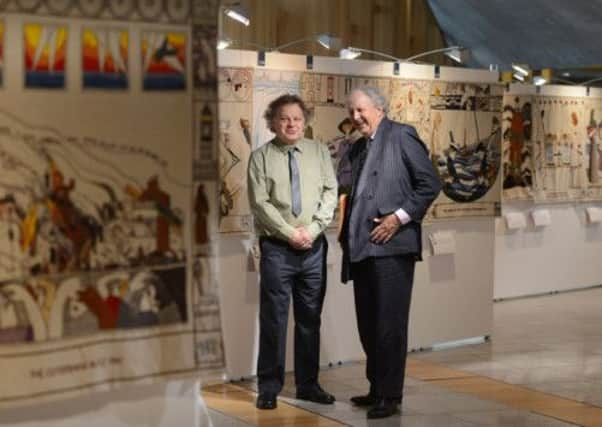Book review: The Great Tapestry of Scotland


The Great Tapestry Of Scotland
Susan Mansfield and Alistair Moffat
Birlinn, £9.99
But then, as he points out, neither is the Bayeux. That most imposing embroidery is an unforgettable visual account of an important episode, as exciting as ever after almost a thousand years. The “Great Tapestry” is worthier, willed into being with a clear consciousness of the precedents and an eye on posterity – but it doesn’t seem so fanciful to imagine it being admired and enjoyed in centuries to come. In 165 beautifully imagined frames, it takes us from the geomorphic formation of the country through to the present day, with a final nod to the prospects for the future. Following a narrative set out by Moffat, it represents the artistic vision of Andrew Crummy, realised by several hundred stitchers under the direction of Dorie Wilkie.
It’s a terrific story, explored in depth, the naivety of the medium deceptive: there is passion, wit and thoughtfulness in these panels. Along with cultural icons from Dennis the Menace to the Old Firm, we find personalities from St Ninian to Sean Connery, from Elsie Inglis to Lulu. Achievements are celebrated, from Bannockburn to the building of the Forth Bridge, but the downs are not ignored – all the news that’s fit to stitch, from the Black Death to the Darien Disaster. There are era-ending defeats at Flodden and Culloden; outrages like Glencoe and the Clearances; and Peru and Iran sending Ally’s Army homeward to think again.
Advertisement
Hide AdA needle’s a needle for a’ that, whether wielded by Mary Queen of Scots or Auntie Morag. This project represents a participatory art echoing a view of history as something involving everybody – the democratic intellect expressed in embroidery. That it frames as fine art what was traditionally “work” is a point that doesn’t have to be laboured; nor does the fact that it gives creative recognition to what was always an activity of women. A number of male stitchers also contributed. Jim Mulrine, who worked on the panel commemorating the founding of the STUC, acquired his skills as an upholsterer in the Clydebank shipyards. As intriguing as the irony is, the point it raises is that Mulrine’s panel – like all the others in the Tapestry – has an unseen story of its own, the little history of how it came to be created, along with the moment it commemorates directly.
Yet it’s also elitist in the right way, Susan Mansfield’s fascinating account makes clear. Made by men and women who, along with their enthusiasm, understand the virtues of care and attention. What they’ve produced is, as Alexander McCall Smith observes in his foreword: “An inspiring and beautiful thing, an expression of love for a country, a gift from many hundreds of people to those who will see it and enjoy it in the future.” We should enjoy it too, he says. “The people we see in this tapestry are, after all, ourselves.”